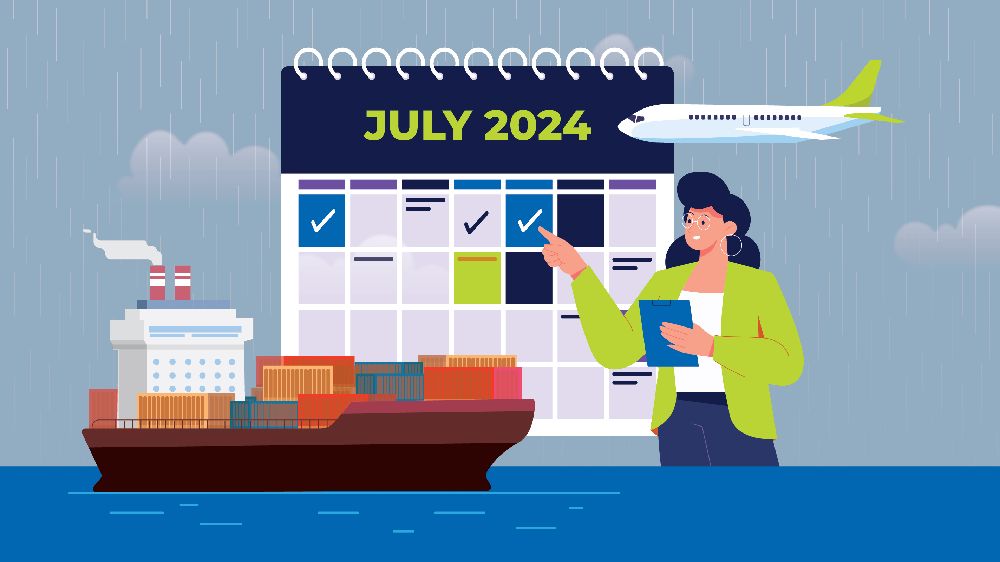
The international business landscape thrives on efficiency and predictability. But for businesses
operating in regions impacted by monsoon seasons, these predictable patterns can be disrupted
by unpredictable weather.
Monsoon seasons, with their unpredictable downpours, strong winds, and flash floods, pose a
significant challenge to the smooth flow of your supply chain. However, by implementing strategic
planning and proactive measures, you can weather the monsoon storm and ensure timely
deliveries.
Understanding the Monsoon Challenges
The key to conquering the monsoon lies in understanding its characteristics
Seasonality: Monsoons typically occur in specific timeframes, varying depending on the region.
Research the historical monsoon patterns for your destination countries to predict the rainy
season's onset and duration.
Impact on Infrastructure: Heavy rainfall can lead to road closures, flight cancellations, and port
disruptions, causing delays in both land and air transportation.
Potential for Delays: Be prepared for potential delays at various stages of the shipping process,
including origin pick-up, customs clearance, and final delivery.
The monsoon season poses certain threats to international shipping:
Disruptions at Ports and Airports: Heavy rains and strong winds can lead to port closures, flight
cancellations, and delays in cargo handling.
Road Closures and Infrastructure Damage: Monsoon rains can cause flooding, landslides, and
damage to roads and bridges, hindering inland transportation.
Increased Risk of Cargo Damage: Water damage, mould growth, and delays due to weather
events can significantly impact the condition of your goods.
How to Plan for a Monsoon-Proof Supply Chain?
Here are some proactive measures you can take to mitigate the impact of monsoon weather on
your international shipments.
Monitor Weather Forecasts Closely
Stay updated on monsoon predictions and potential weather warnings issued by national
meteorological agencies in both - your origin and destination countries. Utilise real-time weather
tracking tools to monitor specific shipping routes and anticipate potential disruptions.
Prioritise Waterproof Packaging
Invest in high-quality, waterproof packaging materials like weatherproof containers, moisture-
resistant liners, and desiccants. Proper packaging helps protect your cargo from moisture
damage and potential mould growth during the monsoon weather.
Consider Insurance Options
Explore monsoon-specific cargo insurance options that offer protection against weather-related
delays and damage. Insurance provides financial security in case of unforeseen circumstances
caused by the monsoon season.
Leverage Technology for Enhanced Visibility
Utilise real-time cargo tracking systems to monitor the location and status of your shipments
throughout their journey. Enhanced visibility allows you to anticipate potential delays and take
necessary actions to mitigate them.
Invest in Contingency Plans
Develop contingency plans outlining alternative routes, storage options, and communication
protocols in case of monsoon disruptions. A pre-defined plan allows you to react swiftly and limit
the impact of unexpected weather events.
Plan and Prepare for a Smooth Sail
Diversify Your Shipping Routes
Don't rely solely on routes heavily impacted by monsoon weather. Explore alternative routes that
might experience less disruption. This might involve working with a logistics partner with a diverse
network of transportation options.
Schedule Buffer Time
Create buffer days in your shipping schedules to account for potential delays caused by
monsoon weather. Communicate these adjusted timelines clearly to your clients to avoid
disappointment.
Strategic Inventory Management
Maintain sufficient inventory levels to accommodate potential shipping delays during the
monsoon season. This ensures you can fulfil customer orders even if shipments experience
setbacks.
Communication is Key
Maintain open and transparent communication with your suppliers, shipping partners, and
customers throughout the monsoon season. Proactive updates regarding potential delays or
route changes can mitigate disruptions and manage expectations.
These strategies will help you weatherproof your business shipping during the monsoon season.
Remember, early planning, open communication, and a focus on risk mitigation are key to
ensuring your global supply chain continues to flow smoothly, even amidst the monsoon's fury. So,
stay informed, adapt your strategies, and keep your shipments moving, rain or shine!
